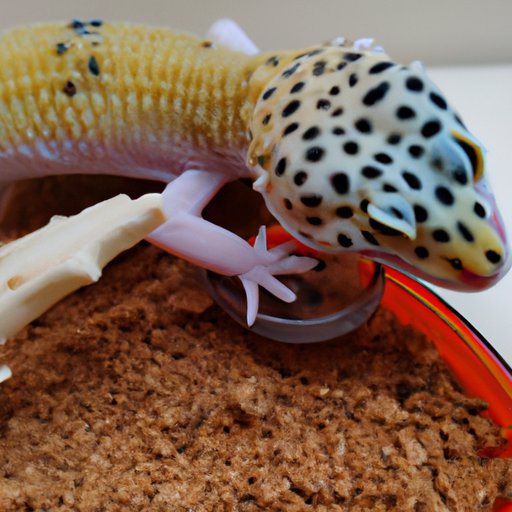Introduction
Leopard geckos are popular pets among reptile enthusiasts due to their docile nature and ease of care. Despite the fact that they are easy to take care of, there are still times when they may not want to eat or have difficulty eating. If you’re having trouble getting your leopard gecko to eat, there are some things you can try to get it to start eating again.

Offer a Variety of Live Insects
Leopard geckos are insectivores, so their diet should consist primarily of live insects. When selecting insects for your leopard gecko, be sure to offer a variety of different types. Some good options include crickets, waxworms, mealworms, superworms, silkworms, and roaches. Offering a variety will help ensure that your gecko is getting all of the essential nutrients it needs.
In addition to offering variety, it is important to make sure the insects you are offering are the appropriate size for your gecko. Feeding your gecko insects that are too large can be dangerous, as they may choke or cause an impaction. If you’re not sure what size insects to offer, err on the side of caution and opt for smaller insects.
Dust with Calcium
Calcium is an important nutrient for leopard geckos and is necessary for their overall health and well-being. To ensure your gecko is getting enough calcium, you should dust its food with a calcium powder supplement. It is best to use one without vitamin D3, as this can lead to hypercalcemia if used in excess.
When dusting your gecko’s food, you should use a light coating of calcium powder on the insects. This will help ensure your gecko is getting enough calcium without overdoing it. Be sure to discard any uneaten insects after feeding, as they may contain too much calcium.
Offer Gut-Loaded Insects
Gut-loading is a process in which insects are fed a nutritious diet before they are offered to your leopard gecko. This helps ensure the insects are packed with nutrients that your gecko needs. You can buy pre-gut-loaded insects from many pet stores, but you can also gut-load them yourself at home.
When gut-loading your own insects, it is important to use a high-quality, nutrient-rich diet. A good option is a commercial cricket diet, as it is specifically formulated for crickets and other insects. You can also use fresh fruits and vegetables, such as apples, oranges, carrots, and leafy greens. Be sure to offer a variety of different foods to ensure your gecko is getting all of the essential nutrients it needs.
Try Different Sizes of Insects
If your leopard gecko is not eating, you may want to try offering different sizes of insects. Smaller insects may be easier for your gecko to catch and eat, while larger insects may provide more nutrition. Offering both small and large insects can help ensure your gecko is getting the nutrition it needs.
It is also important to remember that leopard geckos are nocturnal, so they will likely only be interested in eating at night. If your gecko isn’t eating during the day, try offering food at dusk or in the evening. This may help encourage your gecko to start eating again.
Use Positive Reinforcement
Using positive reinforcement is a great way to encourage your leopard gecko to eat. Try rewarding your gecko with a treat, such as a waxworm or cricket, when it eats. This will help create a positive association with food and will help encourage your gecko to eat more often.
It is also important to remember that leopard geckos can be picky eaters, so it may take some time to find the right combination of insects and sizes that your gecko likes. Don’t give up if your gecko isn’t eating right away – keep trying different combinations until you find one that works.
Conclusion
Getting a leopard gecko to eat can be challenging, but it is possible with the right approach. Offer a variety of live insects, dust them with calcium powder, and offer gut-loaded insects to ensure your gecko is getting the nutrition it needs. Try different sizes of insects and use positive reinforcement to encourage your gecko to eat. With patience and persistence, you can help your leopard gecko enjoy mealtime again.
(Note: Is this article not meeting your expectations? Do you have knowledge or insights to share? Unlock new opportunities and expand your reach by joining our authors team. Click Registration to join us and share your expertise with our readers.)
